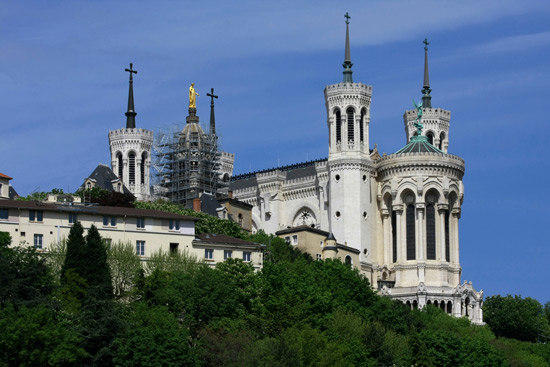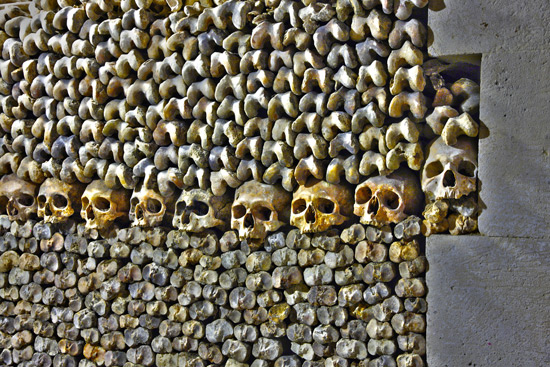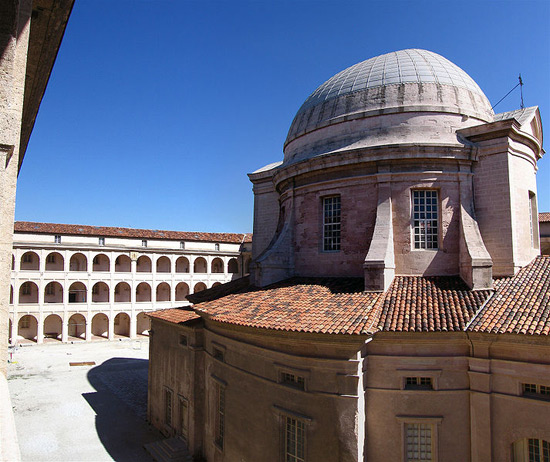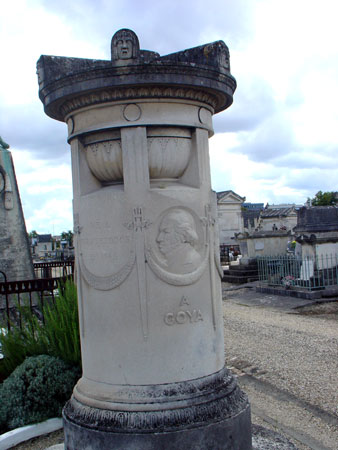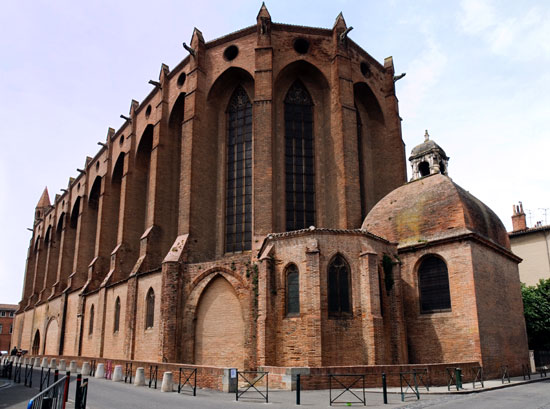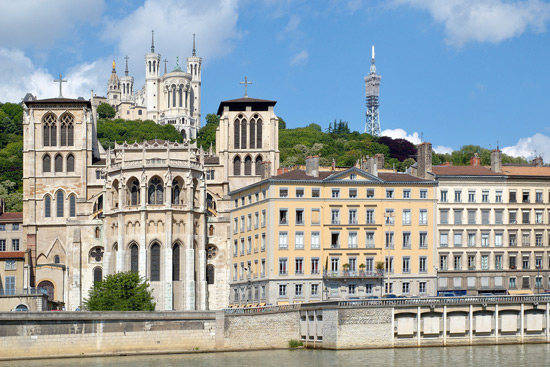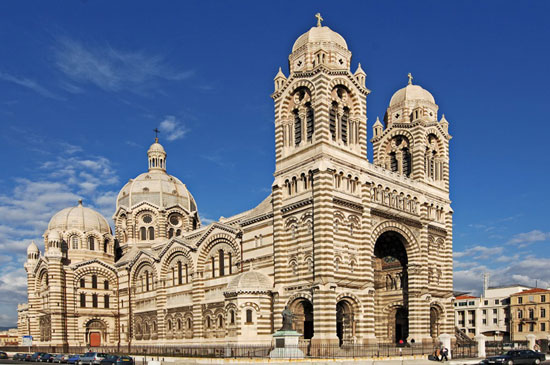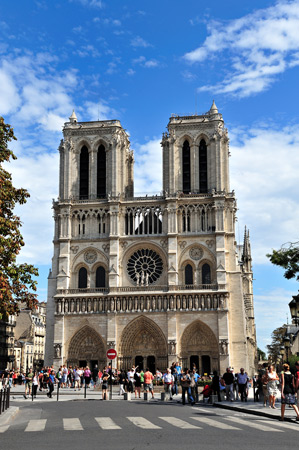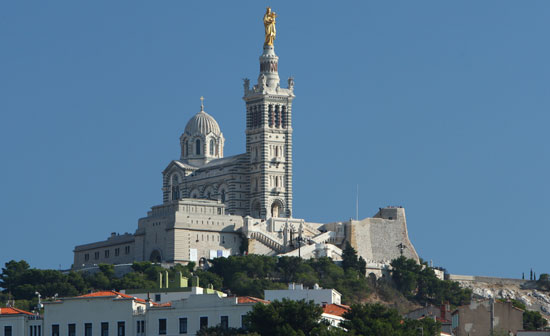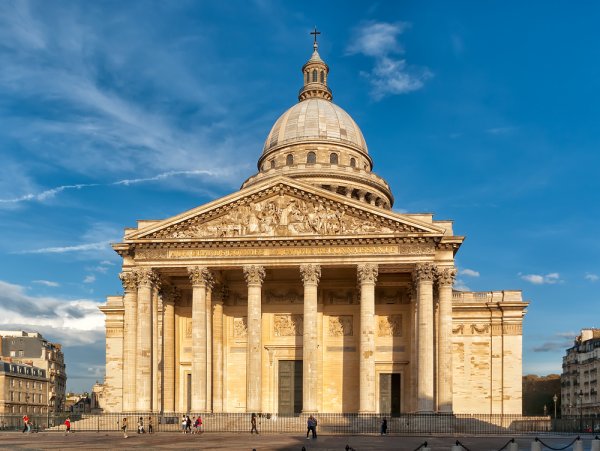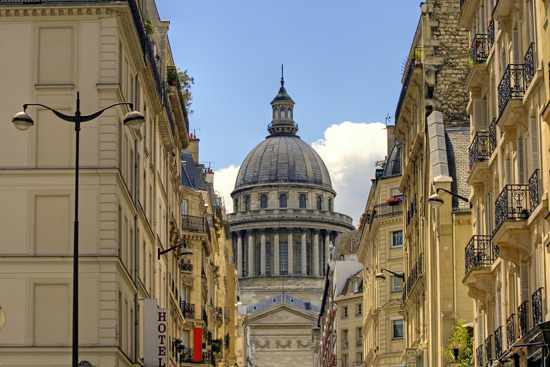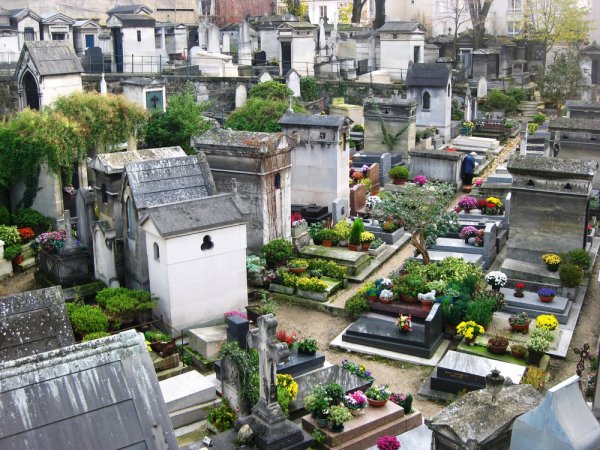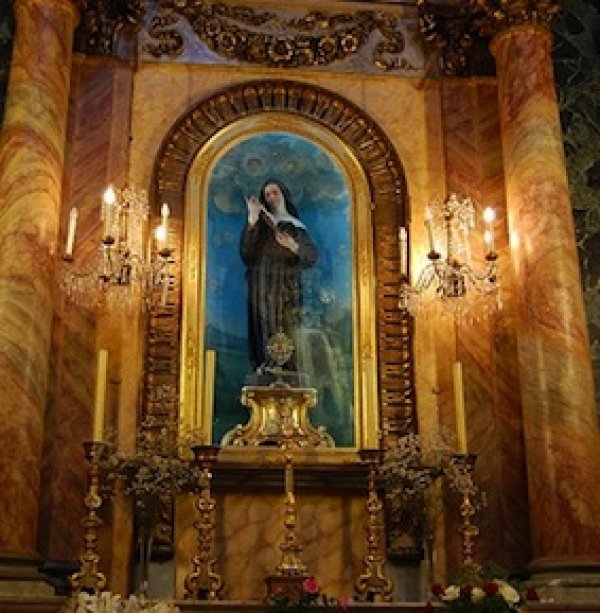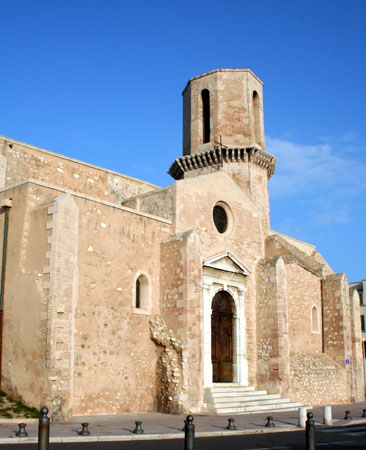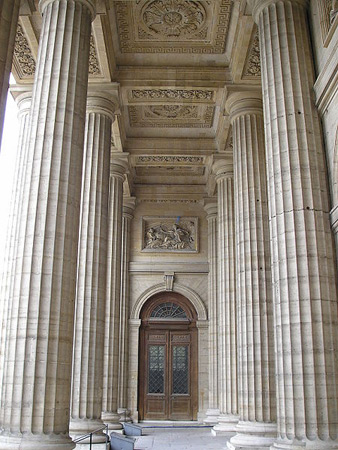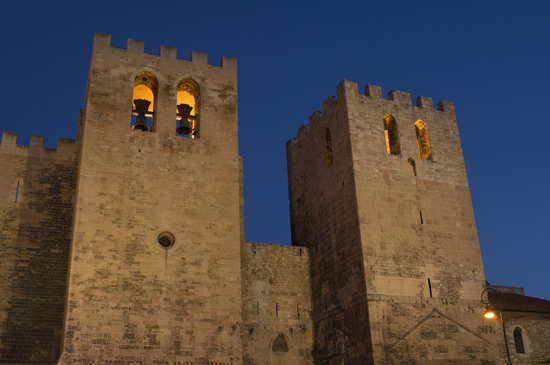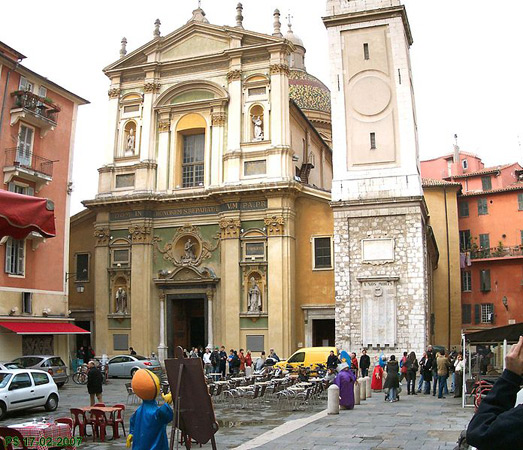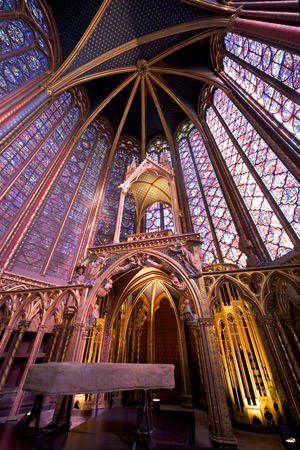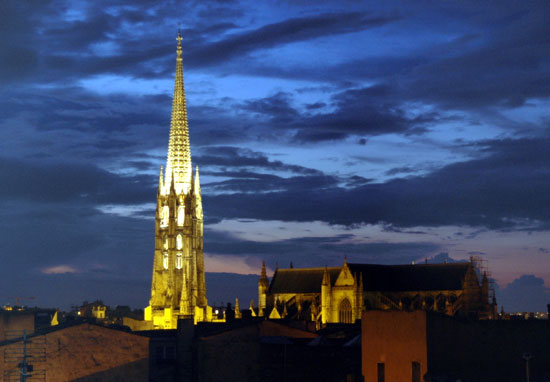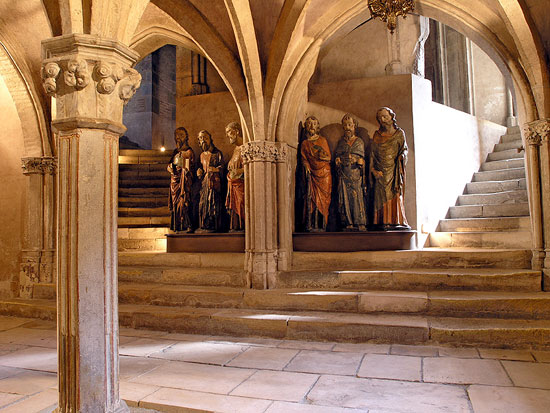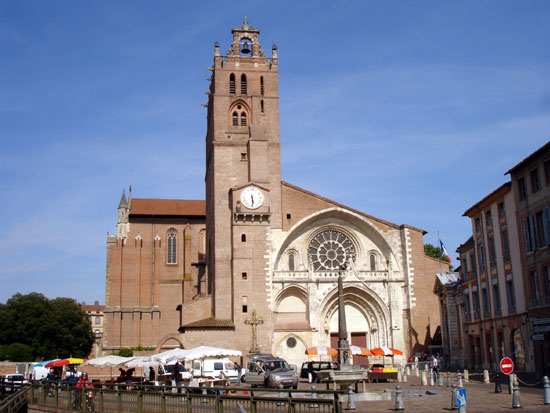Points of Interest
Basilica Notre-Dame de Fourvière
8 Place de Fourvière
Lyon, France
Basilica Notre-Dame de Fourvière is arguably the holiest site in a city. It was built in 1870 to endorse the power of the Roman Catholic Church as a rebuff to the secularization of France's Third Republic. Wherever you are in the city you can see the glowing angelic whiteness of its grand turrets and crenellated walls. The giant golden statue of the Virgin Mary is its most unique aspect, quite unlike anything else you'll see on your travels. Powerful lights shine on it during annual festivities held each October 8, bringing out its full radiance. If you can make it up the 287 steps to the Basilica's observatory then you'll be rewarded with a glorious panoramic view of Lyon.
Basilica of the Sacred Heart
Basilique du Sacré-Cœur 35 rue du Chevalier-de-la-barre
Paris 75018, France
The Basilique du Sacré-Cœur (Basilica of the Sacred Heart) is a Roman Catholic church designed by Paul Abadie in a Romanesque-Byzantine architectural style. The church was built after France’s defeat in the 1870 Franco-Prussian war. Although the foundation stone was laid in 1875, construction work on the church was completed only in 1914. It opened as a place of worship after the First World War. The church is made of a stone that oozes calcite during damp weather, which ensures that the church's white color never changes even in bad weather or heavy pollution. It is a famous landmark located at the summit of Montmartre butte, the highest point in Paris.
Catacombs of Paris
Catacombes de Paris 1 Avenue du Colonel Henri Rol-Tanguy
Paris 75014, France
Originally mines for the stone that built Paris, the network of tunnels was turned into a huge ossuary in the 18th century after the city's cemeteries started overflowing (the famous Parisian cemeteries such as Père Lachaise also date from around this time). It took French administrators 15 months to re-inter the remains of 6 million people, transporting them in black-veiled carts by night. Bones are arranged not by body, but by type (femurs stacked here, tibias piled there). Among the bodies is that of Madame de Pompadour, a victim of the French Revolution. It's said that the aristocratic Comte d'Artois used to throw crazy parties down here. The French Resistance also used the 180 miles of tunnels during World War II. Be warned, there are more than 100 steps, there is no toilet, and the stones can be slippery.
Charitable House
La Vieille Charité 2 Rue de la Charité
Marseille 13002, France
Located in the Panier neighborhood, La Vieille Charité is an imposing baroque chapel embraced within a cloister-style courtyard. Built and designed by Marseillais architect Pierre Puget, the chapel was originally constructed as a free respite for the city's poor. It has also been used as a barracks, a soldiers' shelter, and affordable housing for those displaced by World War II. However, today the pink-hued triple-arcaded courtyard and chapel are home to bookshops, a café, and the marvelous Musée d'Archéologie Méditerranéenne (Museum of Mediterranean Archaeology) and Musée d'Arts Africains, Océaniens & Amérindiens (African, Oceanic, and American Indian Art Museum). This art museum contains extraordinary artifacts, including masks from all over the world.
Chartreuse Cemetery
180 rue Georges-Bonnac
Bordeaux, France
Although it does have a few French household names scattered throughout its gravestones, the Chartreuse Cemetery is more notable for its eclectic stonework and extraordinary diversity of tombs. So while many visitors come to see the mausoleum of Spanish painter Francisco Goya (although he died in Bordeaux, his body is interred in Madrid), others come simply to admire the sepulchral sculptures. From simple stele to full stone kiosks, complete with Norman arches and vaults, the range of monuments is striking and moving. Look out for the statue of Death, hooded and holding a scythe, a macabre forecast for every citizen of Bordeaux, no matter how celebrated. Among the lesser names entombed here are the beatified priest Guillaume-Joseph Chaminade (now known as Blessed Chaminade), painter Pierre Lacour, writer and proto-feminist Flora Tristan (also grandmother to Gauguin), and a couple of French Revolution generals.
Cimiez Monastery
Place du Monastère
Nice, France
Bordered by magnificent Italian gardens overlooking Nice and the Baie des Anges, this Franciscan monastery presents a sundry of artworks and other documents dating from the 15th to 18th centuries, including three important paintings by 15th-century local legends the Bréa brothers. In the convent's chapel, don't miss the carved and gloriously gilded wooden altarpiece. Franciscan friars still dwell in the Musée Franciscain, which is decorated with fine 17th-century frescoes. French fauvist painters Raoul Dufy and Henri Matisse are both buried in the cemetery here.
Jacobin Church
69 rue Pargaminières
Toulouse, France
This Dominican cathedral features one of the most beautiful elements of medieval architecture, the palmier. Look up at this "palm-tree," and marvel at its 22 stone fronds, which radiate outwards to support the roof of the entire apse. Dating from 1230, the palmier and the other six stone pillars are only part of this extraordinary building. Another distinctive element is the Jacobin church's dual nave structure, something architectural historians have debated for decades. Neither historians nor visitors would have anything to discuss, if it wasn't for Prosper Mérimée, a 19th-century historic building inspector. In 1845, he found the old Dominican church a virtual shell, thanks to the artillery troops, materiel, and horses, which had occupied the place since Napoléon's rule. Granted monument status, the church was returned to the state, and slowly restored to its original condition.
Lyon Cathedral
Cathedrale Saint-Jean-Baptiste de Lyon 70 Rue Saint-Jean
Lyon, France
Lyon Cathedral (officially, Cathedrale Saint-Jean-Baptiste de Lyon) was built over several centuries on the site of two major churches of the early Middle Ages, whose remains can be viewed today in the archeological garden next door. The cathedral's greatest moment came in 1600 when it hosted the lavish Renaissance wedding of King Henry VI and Maria de Medici. The 12th-century apse of the building is regarded as the pièce de résistance of Lyonnais architecture, while the window tracery and vaulting of the side chapels is strikingly intricate. The cathedral's distinctive feature has to be the astronomical clock that stands 30 meters (90 feet) high and chimes four times a day.
Marseille Cathedral
Place de la Major
Marseille, France
The Cathedral of Sainte-Marie-Majeure, also called La Major, has a long and storied history. This religious entity was founded in the 4th century, expanded in the 11th, and completely rebuilt between 1852 and 1893 by architects Léon Vaudoyer and Henri-Jacques Espérandieu. With its cupolas, turrets, and towers, the present day Romano-Byzantine Cathedral—which stands at 60 meters (197 feet) high and 140 meters (459 ft) long—dwarfs the remains of the 11th-century cathedral beside it. Because of public protest at the time the newest structure was built, the 11th-century building managed to keep her altar, choir, and transept intact.
Notre-Dame Cathedral
Ile de la Cité 6, Place du Parvis
Paris, France
The Notre-Dame de Paris, commonly referred to simply as Notre-Dame (Our Lady), is a Gothic cathedral and the seat of the Archbishop of Paris. The magnificently constructed building contains beautiful sculptures and stained glass. It is also one of the first buildings in the world to use flying buttresses, which were added to prevent stress fractures. It stands as a fine example of French Gothic architecture and remains an enduringly popular tourist attraction. Originally, though, the addition of buttresses did not sit well with many, who felt it looked like scaffolding and gave the cathedral an unfinished look.
Our Lady of the Guard Basilica
Basilica Notre-Dame de la Garde Rue Fort du Sanctuaire
Marseille, France
La Garde, at 162 meters (530 feet) tall, is Marseille's highest hill; perched on its height, the golden basilica of Notre-Dame can be seen from virtually any point in the city. This fantastic Romano-Byzantine basilica was built by architect Esperandieu in the mid-1800s. Its dome is adorned with colored marble, intricate mosaics, and breathtaking murals, which were restored to their full splendor in 2006. Upon the bell tower, a gilded 10-meter-tall (33-foot-tall) statue of the Virgin Mary holding an infant Jesus stands on an ornate 12-meter-tall (40-foot-tall) pedestal and overlooks the port. Visitors can look for the bullet holes and shrapnel scars left on the northern exterior during Marseille's brutal Battle of Liberation in 1944. As if the architecture of this remarkable landmark weren't enough, visitors are treated to a stunning 360-degree view of Marseille's vast apricot- and terracotta-colored roofs stretched out below the basilica's terrace.
Panthéon
Place du Panthéon
Paris 75005, France
The Panthéon was originally a church dedicated to Sainte-Geneviève. It was built by King Louis XV, who promised to erect a new, beautifully constructed structure on the ruins of the church of Sainte-Geneviève if he recovered from a serious illness he was suffering from. After recovering, he appointed master architect Soufflot for this enormous task. The structure of this building reflects the neoclassical style of architecture, with a façade modeled on the Pantheon in Rome. The top of the structure has a small dome based on Bramante's Tempietto.
Panthéon
Place du Panthéon
Paris, France
The Panthéon was originally a church dedicated to St. Geneviève. It was built by King Louis XV, who promised to erect a new, beautifully constructed structure on the ruins of the church of Sainte-Geneviève if he recovered from a serious illness he was suffering from. After recovering, he appointed master architect Soufflot for this enormous task. The structure of this building reflects the neoclassical style of architecture, with a façade modeled on the Pantheon in Rome. The top of the structure has a small dome based on Bramante's "Tempietto."
Père Lachaise Cemetery
16 rue du Repos
Paris 75020, France
Père Lachaise Cemetery is named after Père François de la Chaise, the confessor of Louis XIV, and was established in 1804 by Emperor Napoleon. The Père Lachaise Cemetery contains about 30,000 graves and is one of most visited cemeteries in the world, attracting hundreds of thousands of visitors every year. It owes its fame to the graves of highly eminent people who are buried here, most of whom have greatly contributed to enhancing French life for the past 200 years. Besides the graves, the cemetery encompasses Paris' largest park and boasts a varied terrain consisting of rolling hills, thousands of trees, twisting paths, and even streets.
Saint Rita Church
1 Rue de la Poissonnerie
Nice, France
Located on the busy, noisy Rue de la Poissonnerie, the Church of Saint Rita is named after another patron saint of the city. Saint Rita, interestingly enough, is the patron saint of the impossible, and dear to the residents of Nice. Technically speaking, this 17th-century church is dedicated to Saint Jacques (or Saint Giaume, according to the Niçois). However the steady flow of devout locals praise St. Rita inside this gilded baroque gem. While a look at the outside of this church is nothing to write home about, the inside is a baroque marvel worthy of a wander. Saint Rita's is filled with multicolored marble, mosaics, detailed gildings and moldings, and other delights.
Saint-Laurent Church
16 Esplanade de la Tourette
Marseille, France
Built in the 1100s, the Roman-Provincial Church of Saint-Laurent is situated where the first Greek temple devoted to the sun god Apollo once stood. In the 17th century, the adjoining chapel of Sainte-Catherine was added. Both structures withstood the destruction of this district (the fishing region of Saint-Jean) during the German occupation in 1943. Thankfully, this allowed the church to retain its austerely beautiful pink limestone façade and some key architectural features unique to Marseille. Inside this charming chapel, one can find several works of art worthy of a look.
Saint-Sulpice
Rue Saint-Sulpice
Paris, France
One of the most distinctive churches in the world, Saint-Sulpice has an unusually wide colonnaded front, framed by two uneven towers. An exercise in 18th-century classicism by Giovanni Servandoni, the church was completed by several architects. The radiant interior contains several murals by Eugène Delacroix. Among the more famous worshippers at this celebrated church were the Marquis de Sade, who was baptized here, and Victor Hugo, who was married here. One of the largest of Paris's churches, the Left Bank site has historically attracted wealthy and aristocratic parishioners. If you're lucky, you'll get the chance to hear the organ, which was played for more than six decades by composer Charles-Marie Widor. More recently, the church was featured in The Da Vinci Code-its floor contains a brass strip known as a "Meridian Line," which was used for astronomical calculations.
Saint-Victor Abbey
Abbaye de Saint-Victor Place Saint-Victor
Marseille 13007, France
Set up on the hill overlooking Vieux Port, the Abbaye de Saint-Victor is one of Europe's most ancient centers for Christian worship. On the site of a former Hellenic burial ground, two monasteries built here in 415 CE; these structures and their successors over the centuries were the scene of heresy, martyrdom, and great prestige. This impressive Romanesque abbey holds the tomb of the eighth-century martyrs and an even older sarcophagus in its eerie crypt and catacomb. A few key Marseille cultural festivities take place at the abbey every year, including a beloved sacred music festival and a religious ceremony at Candlemas, during which a Black Madonna is carried from the crypt along rue Sainte to earn the archbishop's blessing.
Sainte Réparate Cathedral
3 Place Rossetti
Nice 06300, France
This grand cathedral in the old part of Nice is named after the city's patron saint, Sainte Réparate—the 15-year-old virgin martyred in Caesarea in the fourth century and reputedly delivered to Nice in a boat of flowers pulled by two angels. The calm green and beige façade of this cathedral gives no indication of the treasures it holds inside. The luxurious baroque interior, with its three naves and splendid chancel, is replete with thick marble columns, gold embellishments, massive murals, a grand organ, and furnishings adorned with colored stone mosaics. Interestingly, the bell tower looming above the main church was built a century after architect Jean-André Guibert first began work on this Roman Catholic cathedral in the 17th century.
Sainte-Chapelle
4 Boulevard du Palais
Paris, France
On sunny days, the Sainte-Chapelle on the Île de la Cité is breathtaking. Famous for 600 square meters (6,500 square feet) of stained glass windows, this diminutive, almost delicate example of Gothic architecture was constructed for Louis IX, the French king so devout he was later canonized. Louis wanted a chapel to house his most precious religious relics, including Christ's Crown of Thorns, pieces of the Cross, and drops of Christ's blood. He'd purchased these at biblical expense (the relics cost three times more than the building!) from the cash-starved emperor of Constantinople. The soaring vaulted ceiling, thought to be designed by master mason Pierre de Montreuil, is terrific, but it's the kaleidoscope of colors in the Upper Chapel that makes this church so spectacular. Although many visitors try to see Sainte-Chapelle at sunset, it's a smart move to go early in the morning if you want to avoid the long wait for admission.
St. Michael's Basilica
Basilique St-Michel Place Meynard
Bordeaux, France
French pilgrims have been paying their respects at this venerable church since the 15th century. Built in Flamboyant Gothic style, in part by contributions made by Bordeaux's powerful medieval guilds, it still forms a keystone in the chain of churches leading south toward the Spanish pilgrimage city of Santiago de Compostela. Visitors may want to start with the precipitously tall La Fléche bell tower (fléche means arrow), which at 109 meters (358 feet) is one of the highest in the South of France and which stands separately from the basilica. Within the church are fine woodcarvings, alabaster altarpieces from England, and Flemish paintings dating from the 15th century. Two notable attractions that are no longer on show include the stained-glass windows (shattered by Allied bombing during World War II), and the mummified remains discovered beneath the bell tower in 1791: these were displayed for more than a century, but finally laid to rest in 1979.
St. Nicholas Russian Orthodox Cathedral
Avenue Nicolas II
Nice 06000, France
With its onion-like domes sitting atop dazzling towers of blues and oranges, this cathedral is truly one of the most beautiful Orthodox churches outside of Russia. Just one of many Russian attractions in Nice, the Russian Cathedral remains the most illustrious remnant of the Russian aristocracy's affair with the Côte d'Azur. Czar Nicholas II (who ordered and built the cathedral in 1912) and his well-to-do Romanov buddies were lured to the French Riviera for its temperate weather and high-class cultural clout. Both the interior and exterior of this Belle Époque edifice are richly adorned and decked with icons, frescoes, and intricate woodwork. The cathedral is open to tourists, except when church services are held on Sunday mornings.
St. Saturnin's Basilica
Basilique St-Sernin 13 Place St-Sernin
Toulouse, France
This vast basilica is filled with fascinating items and stories, from the largest to the smallest. For starters, it is the largest Romanesque church in the world. Although construction began originally in the 11th century, most of the basilica has been augmented, even the distinctive octagonal tower, which displays both Gothic and Romanesque tiers. For the oldest architectural sections, head to the chevet, the complex series of curving extensions at the end of the nave, which traditionally houses a handful of smaller chapels. For the smallest object, keep an eye out for the thorn-none other (so the basilica's signs claim) than a thorn from the crown worn by Christ during his crucifixion. Saturnin, the martyr for whom the basilica is named, was a Roman Christian sent to convert the Gauls. He died after being lashed to a bull, which dragged him through the streets of Toulouse.
St. Stephen's Cathedral
Place St-Étienne
Toulouse, France
Many religious buildings are constructed in stages, for reasons of cost and complexity. But few look as discombobulated as Toulouse's St. Stephen's Cathedral. Begun in the 11th century, this vast agglomeration of brick and stone would not reach completion until some 600 years later. Its various architectural styles and elements owe as much to the city's religious context as they do to the church's financial well-being. The curiously broad nave (at 19 meters wide, it's virtually square) represented a real statement at a time in the 12th century when the Catholic Church was ideologically besieged by the Cathars. Although this would become a template for French Southern Gothic, successive city bishops were not convinced, adding to the stolid central form their own spectacular touches, such as the 14th century choir, designed in the Flamboyant Gothic style. Even if you're not an architecture vulture, the massive entranceway, brick bell tower, and the 13th-century Rose Window are worth a look.
The Exchange Temple
Temple du Change 3 Place du Change
Lyon, France
A religious site with a quirky back story, the Exchange Temple started life as the stock exchange in the bustling mercantile era. The building was enlarged in 1748 with a new pier, bay, and imperial-style roof. Half a century later it became abandoned, then changed to an inn and then a place of Protestant worship with room for 600 people. Tourists today are drawn to its elegant arched frontage and its highly detailed clock, whose dial not only shows the time but also the day, month, and year. Concerts given by choirs and religious orchestras take place here from time to time, and you may be lucky enough to catch one. The Exchange Temple is classified as a historic monument by the French government.
The Grand Mosque of Lyon
146 Boulevard Pinel
Lyon, France
To get a taste of the history and culture of Lyon's significant Muslim population, head to the Grand Mosque of Lyon. The architecture of the Grand Mosque is remarkable for its 25-meter-high (82-foot-high) high Basilica-rivaling minaret. Dating back only to the last decade, the mosque could be characterized as a mixture of Western modernity and Islamic traditionalism. The portico is arched and sleek in the Persian style, and a mezzanine level for female worshippers is decorated with a gorgeous mosaic inscribed with a quote from the Koran. You can arrange a guided tour through the visitors' center, which will take you around the mosque and into the attached school, library, and 230-column glass pyramid chamber.
Copyright © 1993—2025 World Trade Press. All rights reserved.

 France
France 